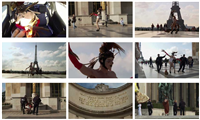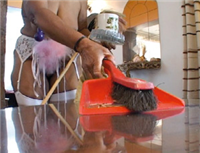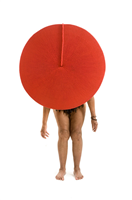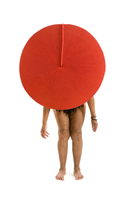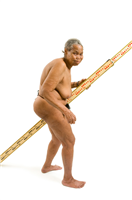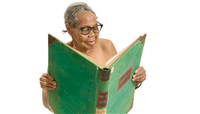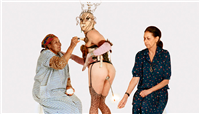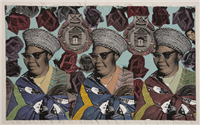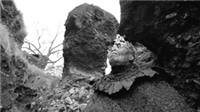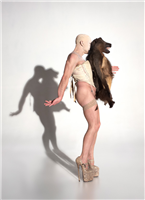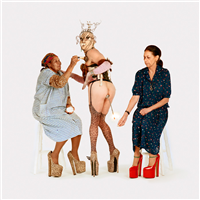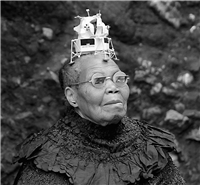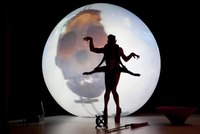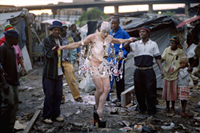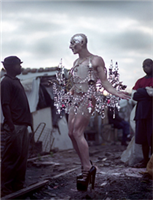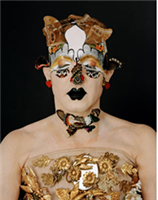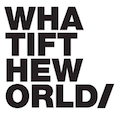Current Review(s)
From the Bottom of Cohen's Heart: A Review of Magog
Steven Cohen at STEVENSON in Cape TownOn the steps of the Reichstag in 1998, a performance by Nomsa Dhlamini and Steven Cohen was interrupted by the German police. German cops, as it turns out, are real sticklers for legality, and the pair had broken several public nudity laws. The site of a naked 80-something year old woman prancing around on the steps of parliament had the police swarming around en masse. Utterly unabashed, Dhlamini pushed through the crowd to confront a police officer, yelling: 'Bums is nothing! My mother walked like this.'
Cohen loves this story. I came across three interviews in which he tells it with equal alacrity years apart, and I can see why. It’s charming. It has all the ingredients of a good yarn: the culture clash, the generational clash, art fighting the law and winning and a touch of the risqué thrown in for good measure. Besides, the vision of an elderly mostly naked black woman shouting down a police officer (whom I picture blonde and dapper and painfully Aryan) appeals to the rebel in us all.
18 October 2012 - 24 November 2012
Resubjugating the Black Body: A Review of Steven Cohen's Magog
Steven Cohen at STEVENSON in Cape TownThe body and nudity have always been central in art making and thought. But as various feminists have argued, the discourse of art has endlessly examined these themes, largely at the expense of women. Similarly, Prof. V.Y. Mudimbe draws conclusions on how contemporary art re-enacts the imperialist schema through a rendition of blacks as fungible objects - that is to say they are represented without a specific identity. And it is fifteen years since Okwui Enwezor critically adumbrated this point in his essay ‘Reframing the Black Subject’ with specific reference to South African art. Though with its own limitations, Enwezor’s critical labouring debunked the residual racist assumptions of the general imaginary of white South Africa.
Of course today the pervading problem of racism remains safely insulated and ineffable, and Enwezor’s concerns, despite Grey Areas (Brenda Atkinson and Candice Breitz’s critical rejoinder to Enwezor’s assertions), still linger. To be sure, the presiding understanding of the problem still seems to be predicated, almost wholeheartedly, on the understanding of racism as something contingent rather than inherently structural.
18 October 2012 - 24 November 2012
Listings(s)
Steven Cohen at Théâtre d’Orléans
Steven Cohen at Théâtre d’OrléansSteven Cohen will be performing his piece 'Chandelier' for two nights only at the Théâtre d’Orléans.
There will be two showings at 7pm and at 9:30 pm on the nights of Wednesday, March 3 and Thursday, March 4.
The work was first performed as a public intervention in a shack settlement under the M1 highway, in Newtown, Johannesburg.
03 March 2010 - 04 March 2010
Chandelier: a Film Installation by Steven Cohen
Steven Cohen at KZNSA GalleryThe KZNSA's Electric Gallery plays host to one of Steven Cohen's best-known filmed performances. In Chandelier, Cohen dressed fabulously in vertiginous heels and an illuminated chandelier tutu, interacted with residents of a squatter camp in Newtown, Johannesburg, while it was in the process of being destroyed.
11 May 2010 - 30 May 2010
'ARS 11'
Mary Sibande, Pieter Hugo, Steven Cohen, Kudzanai Chiurai, Nandipha Mntambo and Andrew Putter at Museum of Contemporary Art Kiasma'ARS 11' is a major international art event filling Helsinki's Kiasma Museum of Contemporary Art with artworks, performances, screenings, discussions and workshops, and extending to eight cities in Finland as well as to Stockholm, Sweden. Investigating Africa in contemporary art, the exhibition includes not only artists living in Africa, but also those who live outside the continent; artists of African descent as well as Western artists who address African issues in their work. The exhibition features some 300 works by a total of 30 artists, including Mary Sibande, Kudzanai Chiurai, Nandipha Mntambo, Andrew Putter, Steven Cohen and Pieter Hugo.
15 April 2011 - 27 November 2011
'No Fashion, Please! Photography between Gender and Lifestyle'
Steven Cohen and Viviane Sassen at Kunsthalle WienThe rejection of traditional ideas of fashion and beauty characterizes the second show of the Kunsthalle Wien’s autumn programme focusing on photography and fashion. Nineteen solo presentations outline the contemporary international photography scene that explores the fundamental relationship between bodies and clothes, the dialectics between the form of the body and its appearance. The selected photographers are rooted in the tradition of body art and strongly rely on references to installations, ceremonies, and rituals. Borders to other disciplines are crossed in both daring and reckless experiments. In the context of the exhibition, clothes and other products of the fashion industry only figure as fragments of a narrative mise-en-scène thematizing the dreams concerned with a changing aesthetic of the body and its ideals. The media strategies employed are manifold and span from staged photographic images, projections, and performances to body sculptures, video and film works.
10 November 2011 - 22 January 2012
'Revolution vs Revolution'
David Goldblatt, Steven Cohen and William Kentridge at Beirut Art CentreSince 2010, countries from the Arab world have been going through a period of rapid and radical change. Events from the Atlantic to the Arabian Gulf promise new previously unforeseeable trajectories. A new narrative is unfolding.??
It is in this context and in the light of these historical events that Beirut Art Center presents an exhibition and series of events exploring other junctures from the last fifty years that have led to radical changes, such as revolutions, the rise and fall of regimes and ideologies, as well as social and political movements whose effects were felt around the world and to this day. This includes important movements like the Iranian Revolution of 1979, the dissolution of the Soviet Union and fall of Communism in Europe, the Chinese Cultural Revolution, the end of Apartheid, the student riots in the 60s, as well as Nasserism and the rise of Arab Nationalism.
03 February 2012 - 30 March 2012
'Artistic Practice and Social Imaginaries' - 11th Havana Biennial
Doreen Southwood, Steven Cohen, Kathryn Smith, Trinity Sessions and Nontsikelelo Veleko at Various venues around HavanaThe 2012 Havana Biennial explores the relationship between visual productions and the social imaginary, referring to the way people imagine their social space and express themselves through cultural and historical references. Besides fine arts exhibitions, the Havana Biennial will include lectures, workshops and master classes, documentaries, performances and video screenings in sites across the city.
11 May 2012 - 11 June 2012
'Magog'
Steven Cohen at STEVENSON in Cape Town'Magog', Steven Cohen's second solo exhibition at Stevenson, focuses on works made by the artist with Nomsa Dhlamini, the domestic worker who helped raise him and who, aged 92, continues to play a pivotal role in his life and work.
The intimate relationship between Cohen and Dhlamini is foregrounded in The Cradle of Humankind, the performance piece that showed at the National Arts Festival, Grahamstown, in July this year. Including video shot at the Sterkfontein Caves, where many of the world's oldest hominid fossils have been found, Cradle 'was supposed to be about evolution', Cohen has said, but 'turned out to be a work about love'. In their various encounters, Cohen and Dhlamini appear as first humans, direct descendants of the apes; as people of contrasting skin colours, subject to anthropological classification; as luminous beings clad in brilliant costumes of fiber-optic light. The exhibition features new works relating to the Cradle performance and conceived for the gallery, including a video of Cohen and Dhlamini's interventions in the caves, and studio photographs.
Dhlamini takes centre stage as the subject and star of the video piece Maid in South Africa (2005), in which she sheds traditional clothing and performs the role of a domestic, cleaning and cooking while dressed in provocatively sexy attire. Of this challenging work, Cohen wrote at the time of its making:
'I am interested in the politics of nudity, not in sex as commerce. This work is more about the slave trade than the flesh trade. This is a personal film and a portrait of apartheid, a naive striptease and a personal confession. ... For 58 years, Nomsa Dhlamini maintained the houses of white people, cleaned their homes, fed their families and looked after their dogs. Maid in South Africa is not titillation but the simple truth ... We are unable to enjoy the luxury of not looking. We look. We see Nomsa's life, without glamour, spending her time cleaning the uncleanable, and her dignity in the face of exploitation.'
The connected roles of Dhlamini and Cohen's mother are dramatised in the 1998 photograph titled (in Yiddish) As die Muter Shreit Oifen Kind 'Mamzer', Meg Men Ir Gloiben (When a Mother Shouts at Her Child 'Bastard', You Can Believe Her), in which Cohen, in leopard-print stockings and heels, is flanked by these two muses, who respectively apply make-up to his chest and light a firecracker inserted in his arse.
18 October 2012 - 24 November 2012

